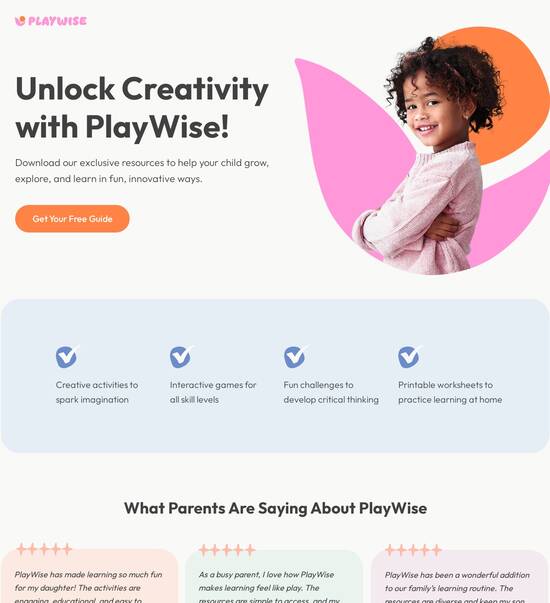
Awesome company history page template
Explore Similar TemplatesAbout template
Unleash your creativity with the awesome company history page template. Try Instapage today.
Recommended templates

Easy to build without coding
With the intuitive drag-and-drop builder, anyone on your team can create high-converting pages without any knowledge of code or design. Make enhancements to your landing page with custom widgets using Javascript, HTML/CSS, or third-party scripts.

Multiple layouts for any industry and goal
Select from 500+ landing page layouts built to boost conversions across industry-specific scenarios. Customize them by adjusting fonts, adding images, and generating on-brand content with the AI assistant. Quickly scale with Instablocks® and Global Blocks that you can save, reuse, and update globally.

Loads fast and looks polished on any device
Every template is responsive, which means they present professionally on any device and load blazingly fast with our Thor Render Engine. You can also power them up with Google AMP technology to deliver an unparalleled mobile experience and drive higher conversions.

Robust analytics & experimentation
Get real-time updates and reporting across all your devices, showing the number of visitors, conversions, cost-per-visitor, and cost-per-lead. Launch AI-powered experiments, run A/B tests, and use heatmaps to analyze user behavior, then optimize your landing page to maximize conversions.







Easy to build without coding
With the intuitive drag-and-drop builder, anyone on your team can create high-converting pages without any knowledge of code or design. Make enhancements to your landing page with custom widgets using Javascript, HTML/CSS, or third-party scripts.
Multiple layouts for any industry and goal
Select from 500+ landing page layouts built to boost conversions across industry-specific scenarios. Customize them by adjusting fonts, adding images, and generating on-brand content with the AI assistant. Quickly scale with Instablocks® and Global Blocks that you can save, reuse, and update globally.
Loads fast and looks polished on any device
Every template is responsive, which means they present professionally on any device and load blazingly fast with our Thor Render Engine.
Robust analytics & experimentation
Get real-time updates and reporting across all your devices, showing the number of visitors, conversions, cost-per-visitor, and cost-per-lead. Launch AI-powered experiments, run A/B tests, and use heatmaps to analyze user behavior, then optimize your landing page to maximize conversions.
All the features you need to build lead-generating landing pages
Explore more featuresLearn how to build top-performing landing pages for any goal
FAQs
Leading the way in building high-performing landing pages





A comprehensive guide to using Instapage for creating high-converting landing pages
When optimizing and scaling your digital marketing campaigns, leveraging a powerful landing page and conversion rate optimization (CRO) platform like Instapage can significantly enhance your results. Instapage's extensive array of features and templates allows marketers to create high-converting pages tailored to their target audiences, especially beneficial for industries such as financial services and education.
Why choose Instapage for your landing pages?
Instapage stands out in the crowded marketplace of landing page creation tools due to its all-in-one capabilities designed specifically for marketers. This platform is equipped with tools for rapid page creation, performance optimization, and collaboration among teams, ensuring that campaigns can be executed swiftly and efficiently. These features are crucial for organizations across various sectors, including tech, marketing, and government.
- 100+ ready-to-use templates: Access a wide variety of high-converting layouts tailored to different industries which can greatly reduce setup time.
- Built-in experimentation features: Conduct A/B testing to refine and optimize your landing pages for maximum conversions based on detailed heatmaps.
- Collaboration tools: Facilitate real-time feedback and edits to streamline workflow, making it easier for teams to work together.
Step 1: Creating your landing page
Designing your landing page with Instapage is straightforward. Start by choosing a template that fits your marketing goals. Following this, you can customize elements through intuitive drag-and-drop functionality.
Step 2: Optimizing for conversions
Once your page is designed, it’s vital to focus on optimization. Use the analytics dashboard to track visitor behavior, identifying which areas of your page attract the most engagement.
- Implement A/B tests: Experiment with different headlines and CTAs to see which resonate best with your audience.
- Analyze heatmaps: Understand user behavior by analyzing how visitors navigate your page.
- Utilize personalized content: Tailor your messaging based on audience segmentation and behavior.
Step 3: Launching and analyzing performance
After launching your landing page, continually monitor its performance. Utilize Instapage’s robust performance metrics to adjust your strategy and maximize ROI.
- Track conversion rates: Keep an eye on how well your page is converting leads into customers.
- Adjust your strategies: Be proactive based on insights gained from the analytics provided.
- Regularly update content: To keep your pages fresh and relevant, update your landing page content based on current trends.
In essence, using Instapage not only simplifies the landing page creation process but also empowers marketers to achieve higher conversions effectively.
Ready to transform your digital marketing campaigns? Start using Instapage today to unlock powerful landing page creation tools that elevate your ROI!
Awesome company history page template: engage your audience
Crafting an engaging company history page: The foundation of your brand identity
Creating an engaging company history page is crucial for establishing your brand identity. Your history page acts as a narrative bridge connecting your past with potential customers and stakeholders. This isn't just a rundown of who you are; it's a chance to articulate your journey and values in a way that captivates your audience.
A well-structured company history page serves multiple purposes, primarily establishing credibility and building trust. As a marketer, it’s essential to showcase your brand's evolution while highlighting milestones that have defined its identity. When done correctly, your narrative can resonate deeply with your audience, creating an emotional connection that fosters brand loyalty.
Establishing credibility and building trust: A strong history creates a foundation for credibility.
Showcasing brand evolution and milestones: Highlight milestones that define your company's journey.
Creating a narrative that resonates with your audience: A compelling story engages and connects emotionally.
The role of storytelling in company history
Storytelling is vital in conveying your company’s history effectively. Personal anecdotes can deepen engagement, making your story relatable and memorable. When consumers feel a connection to your brand, they are more likely to choose your products or services over competitors'.
Industries such as tech and retail, where competition is fierce, can significantly benefit from effective storytelling. A compelling brand narrative can convert potential leads into loyal customers, making it a powerful tool for marketing strategies.
How personal anecdotes can deepen engagement: Personal stories humanize the brand.
The impact of a compelling brand narrative on leads: Strong narratives can convert leads into customers.
Industries that benefit most from a strong story: Competitive sectors gain more from effective storytelling.
Visual design elements that enhance engagement
The visual design of your company history page significantly impacts user experience. Structuring content to maintain a logical flow and enhancing readability through thoughtful layout considerations is imperative. Layouts that guide the reader’s eye and optimize engagement are pivotal in retaining visitor interest.
Effective use of whitespace is not just about aesthetics; it also plays a critical role in directing attention to crucial areas. The visual hierarchy can help readers naturally navigate through the page, keeping them focused on the essential milestones and stories.
Structuring content for flow and readability: Content should be easy to follow.
Utilizing whitespace effectively: Whitespace enhances focus and readability.
Visual hierarchy: Guiding the reader’s eye: A clear structure aids information retention.
Integrating multimedia elements
Integrating multimedia elements such as images and videos can significantly enrich your storytelling efforts. Well-chosen visuals not only break up text-heavy content but also allow for a richer narrative experience. Infographics can be used effectively to convey brief snapshots of your history, making complex information digestible at a glance.
Timelines are another interactive tool that can visualize key events in your company's history, allowing visitors to see your evolution over the years at a glance. Effective use of multimedia makes the content engaging while reinforcing the narrative you're sharing.
The power of images and videos in storytelling: Visuals create a deeper emotional impact.
Infographics as a tool for conveying brief history snapshots: They present complex data simply.
Using timelines to visualize key events: Timelines can depict progress visually.
Core components of an awesome company history page template
An engaging company history page template has several core components that enhance storytelling. First and foremost, the brand's founding story should be prominently featured. Highlighting the inspiration behind the brand and the context of the industry at the time of inception not only provides background but also connects emotionally with your visitors.
Including personal touches from the solopreneur’s journey can also humanize your narrative. The combination of industry context and personal anecdotes creates a rich foundation for readers to understand your brand's origins.
Highlighting the inspiration behind the brand: Share what sparked the creation.
The context of the industry at the time of inception: Provide historical context for relevance.
Personal touches from the solopreneur's journey: Make the story authentic and relatable.
Notable milestones and product evolution
Showcasing key dates and events that have shaped the company is essential for illustrating your growth journey. Highlight specific products that have defined your brand’s identity over the years. Consider using timelines or graphical elements to illustrate product transformations and key innovations that have influenced your trajectory.
This component is particularly valuable for industries such as tech, where rapid innovation and adaptability are vital for survival. Readers appreciate transparency about how a company evolves, learns, and responds to market changes.
Key dates and events that shaped the company: Highlight transformative moments.
Highlighting products that have defined the brand's identity: Show how products evolved.
Techniques for showcasing product transformations over time: Graphical representations work well.
Leadership and team contributions
A recognition of your core team and their strategic roles can go a long way in establishing authenticity. Sharing biographies or unique achievements of team members helps visitors connect with the brand on a personal level. Highlighting how leadership has influenced company culture and strategy is also crucial, as it provides context about the company’s present state and vision for the future.
Ultimately, readers will feel a personal connection not just to the company but to the individuals behind it.
Presenting the core team and their strategic roles: Increase relatability with human touch.
Sharing unique achievements within various sectors of the company: Showcase innovation and contributions.
The influence of leadership on company culture and strategy: Explain how leadership impacts direction.
Highlighting impact reports and achievements
To substantiate your company’s credibility, incorporating quantitative data into your history page can be particularly effective. Presenting metrics that matter, such as growth percentages or market share, helps to reinforce your narrative. Consider showcasing awards and recognitions within the industry, as these lend additional weight to your claims.
Furthermore, displaying key performance indicators through graphs or infographics can visually summarize your achievements. This tactic helps potential customers understand not just where you've come from but also where you're going.
Incorporating quantitative data to reinforce credibility: Metrics build trust.
Displaying awards and recognitions within the industry: Third-party validations help.
Key performance indicators that tell your story: Showcase relevant performance data.
Client success stories and testimonials
Customer experiences play a vital role in shaping brand narratives. Incorporating client testimonials can illustrate the real-world impacts of your offerings. This not only adds authenticity but also strengthens your credibility, making it easier to convert page visitors into leads.
Successful stories can be showcased on your company history page, helping to highlight how your products or services have positively affected your clients. This data offers prospective customers a glimpse into their potential journey with your company.
How customer experiences shape brand narratives: Real stories resonate more.
Leveraging testimonials to strengthen leads: Authentic voices can drive conversions.
The role of success stories in converting visitors to clients: These narratives are persuasive.
SEO strategies for enhancing search performance
SEO strategies play a key role in ensuring your company history page reaches its audience. Conducting thorough keyword research specific to company history pages can help identify terms that resonate within your industry. Utilizing these keywords in your headers, body text, and alt text for images will boost your page's visibility on search engines.
Optimizing on-page elements like meta descriptions and headlines is equally important, as they create the first impression in search results. Well-crafted, keyword-relevant descriptions can attract clicks while ensuring readability and engagement.
Identifying terms that resonate within your industry: Focus on your niche language.
Optimizing on-page elements for search visibility: Keywords should be integrated naturally.
Fostering backlinks through storytelling: High-quality storytelling can attract citations.
Crafting compelling meta descriptions and headlines
When summarizing your brand story succinctly, ensure that your meta descriptions and headlines are both compelling and informative. This summary should entice users to click while encapsulating the essence of your company narrative. The power of engaging language cannot be underestimated; the right words can draw in potential clients and spark their curiosity.
While incorporating keywords for SEO, strive for a balance where clarity and readability are not sacrificed. This ensures that even if users don't click through from search engines, they are still left with a solid understanding of what your company encompasses.
Techniques for summarizing your brand story succinctly: Create enticing meta descriptions.
The power of compelling language to attract clicks: Use evocative language.
Ensuring keyword relevance without sacrificing readability: Keep it natural and engaging.
Best practices for maintaining and updating content
Regularly updating your company history page is essential for keeping it relevant and engaging. Monitoring changes in leadership and shifts in company direction should be documented, ensuring that your historical narrative keeps pace with your evolution. Regular reviews of your page content will help maintain its freshness and relevance.
Incorporating new testimonials and success stories can also help keep your audience engaged. The dynamic nature of your industry should reflect in the company history page, and adapting to climactic events or leadership changes is critical for brand integrity.
Documenting shifts in strategy and product offerings: Stay current to remain relevant.
Keeping the history page relevant and engaging: Regular updates maintain visitor interest.
Regularly integrating new testimonials and success stories: Keep narratives fresh.
Scheduled reviews and refreshes of page content
Conducting periodic assessments of historical accuracy is essential. The world is constantly changing, and ensuring your history page reflects this reality will bolster your brand image. Strategies for incorporating current events, product updates, or industry shifts can breathe life into your content, making it a true reflection of where your company stands today.
Keeping your company history page fresh not only aids in maintaining audience interest but also establishes a transparent and authentic brand identity. Regular assessments are crucial for longevity in maintaining relevance.
Importance of periodic assessments of historical accuracy: Ensure your narrative stays truthfully.
Strategies for incorporating current events: Stay relevant in changing markets.
Benefits of staying fresh: Maintaining audience interest through regular updates.
The broader context: Learning from leading brands
Analyzing effective company history pages from leading brands can provide valuable insights. For example, tech companies often utilize interactive elements that allow visitors to explore rather than just read, enhancing engagement. Retail brands frequently highlight sustainability milestones and their impact on the community, showing their active role in current issues.
Understanding what makes these stories compelling can inform your approach. Identifying and adopting elements from other brands’ narratives may lead to refreshing your own story in ways that enhance connection with your audience.
Analysis of industry-specific examples (tech, retail, etc.): Study successful case studies.
What makes their stories particularly compelling?: Identify engaging elements.
Innovations that other brands have implemented: Explore novel strategies.
Trends driving change in company storytelling
The shift from traditional to digital storytelling significantly impacts how companies present their histories. The rise of social media has ushered in a new era of real-time engagement and feedback. As consumers increasingly demand authenticity and transparency, companies must adapt their narratives to reflect collective experiences rather than just a corporate lens.
Moreover, interactive stories and gamification are emerging as powerful tools for engagement. They offer unique ways for audiences to connect with a brand’s journey, allowing them to become part of the brand story.
The shift from traditional to digital storytelling: Adapt to modern media.
How social media has influenced the presentation of company history: Real-time engagement matters.
The emergence of interactive stories and engagement strategies: Greater audience involvement.
Interactive elements: Webinars and engagement tools
Incorporating live discussions or webinars helps build a community around your brand stories. By allowing direct interaction with your audience, you create a shared narrative space where customers can connect over personal stories and experiences related to your company.
Successful case studies illustrate that engaging customers through interactive platforms can enhance loyalty and create brand advocates. Use technology to bring your historical narratives to life in a way that fosters community.
Building community around brand stories: Engage your audience in shared narratives.
Utilizing platforms for direct interaction with your audience: Foster conversation.
Case studies on successful webinar implementations: Leverage user feedback and experiences.
Encouraging audience contributions to the brand story
Creating spaces for customer experiences and feedback can enrich your brand narrative. When customers feel encouraged to share their stories, it fosters a sense of loyalty and investment in the brand. Providing avenues for this kind of community engagement helps you tap into the collective history of your consumer base.
Actively listening to and incorporating customer feedback not only enhances your story but also establishes a two-way relationship. This interactive approach can create strong brand advocates among your audience.
Creating spaces for customer experiences and feedback: Build a platform for shared stories.
The impact of community engagement on brand loyalty: Strengthen connections with customers.
Tapping into the collective history of your consumer base: Leverage community narratives.
Ready to skyrocket conversions?
Supercharge your ad campaigns with high-performing landing pages
Get started














